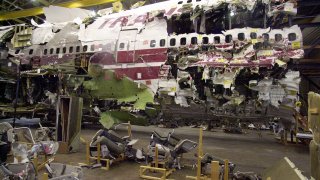
The reconstructed wreckage of one of the deadliest crashes in U.S. aviation history has spent the last 25 years serving as an important teaching tool for investigators that has likely helped save lives.
Now the reconstructed remains of TWA Flight 800 from July 17, 1996, are being dismantled and will later be destroyed out of respect for the loved ones of the 230 people who died on that tragic day.
"I appreciate what the families sacrificed in order for it to be here," Sharon Bryson, the managing director of the National Transportation Safety Board, told Peter Alexander on TODAY Wednesday.
Joe Lychner lost his wife, Pam, and his young daughters, Shannon and Katie, when the Boeing 747-100 bound for Paris exploded shortly after takeoff out of New York's John F. Kennedy International Airport and killed everyone onboard. He had just spoken to his wife shortly before his family boarded the plane.
Get Tri-state area news delivered to your inbox. Sign up for NBC New York's News Headlines newsletter.
"I could hear the girls running, I mean running around the phone booth at that time and just playing and enjoying themselves and having a great time," he said. "And they were so excited to be going to Paris. That is the thought that will always live with me."
U.S. & World
Heidi Snow Cinader lost her fiancé, Michael Breistroff, in the explosion.
"Everybody's direction in life changed at that moment when that plane went down," she said.
The four-year investigation into the crash was one of the most exhaustive in aviation history and led to fundamental changes in the way aircraft are constructed.

Investigators recovered 95% of the plane's wreckage and reconstructed it in a hangar in New York before transporting it to the NTSB training center in northern Virginia in 2003.
That wreckage was crucial in helping the NTSB determine the crash was likely caused by an electrical spark that ignited fumes inside the center fuel tank.
"This wreckage helped teach investigators valuable safety lessons, producing recommendations that fundamentally changed the way aircraft are designed, from how they're wired to reducing the potential for explosions in the fuel tank," Frank Hilldrup, chief technical adviser for international affairs at the NTSB, told Alexander.
The NTSB determined that the wreckage is no longer needed as a training tool because of advances in digital 3D scanning and drone imagery, according to a news release in February. The wreckage will be dismantled on Wednesday and then later destroyed.
While the reconstructed wreckage being destroyed closes a chapter in the tragedy, people like Cinader have continued to keep the memories of the victims alive and help others who have experienced similar loss.
Cinader founded the nonprofit AirCraft Casualty Emotional Support Services to provide grief support for people who have lost loved ones in air disasters.
"I found it so important to be able to talk to other people who have been through it before," she said.
This story first appeared on TODAY.com. More from TODAY:



